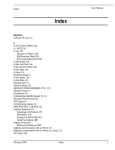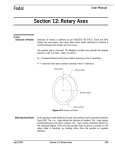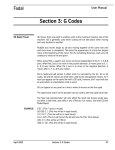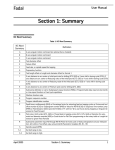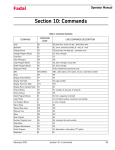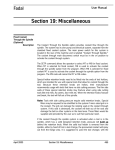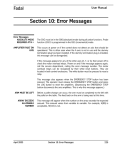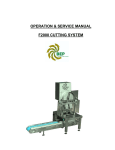Download Fixed Cycles - Flint Machine Tools, Inc.
Transcript
Fadal User Manual Section 4: Fixed Cycles Definition A Fixed Cycle is a series of operations that directs Z axis and spindle movement to execute such actions as boring, drilling, and tapping. G codes 73-76 and 81-89 define the operation, while F, I, J, K, P, Q, R0, and Z words (cycle parameters) define the style of execution. Procedure to Initialize a Fixed Cycle 1) Turn spindle on (M3,M4) at the desired RPM. 2) Position the tool to the I plane (Initial plane), a point above the part and fixture where the tool will clear all objects. 3) Define the Fixed Cycle with its parameters. 4) Specify a move with X, Y, A, or B locations to execute the cycle. O1234 (DRILLING EXAMPLE G0 G90 S10000 M3 E1 X.5 Y-.5 Start the spindle H1 M8 Z.1 Position to the I plane G82 G99 R0+.1 Z-.25 F45. P18 Define the cycle and its parameters X1. Y-.6 Cycle is executed at this next location I Plane The I plane (initial plane) is automatically established by the last Z axis position when the fixed cycle is defined. This is commonly called the maximum Z clearance position. It is usually established above the highest object on the part or fixture. It is used with the G98 code to “jump” over obstacles on the part or fixture. The I plane must always be equal to or above the R plane. O1234 (DRILLING EXAMPLE G90 G0 S10000 M3 E1 X.5 Y-.5 Start the spindle H1 M8 Z1. Z.1 Position to the I plane. The I plane is the last Z position before the cycle line. G81 G99 R0+.1 Z-.72 F45. Define the cycle. The R0 plane is equal to the I plane. X1. Y-.6 Cycle is executed at this next location April 2003 Section 4: Fixed Cycles 75 Fadal User Manual This represents the location of the R0 plane (or minimum clearance plane). The R0 plane is where the tool will begin to feed into the material. This location must be below or equal to the I plane. R Plane EXAMPLE: G90 where the I is equal to the R0 plane G90 Z.1 G81 R0+.1 EXAMPLE: G91 where the I is equal to the R plane G90 Z.1 G91 G81 R0+0 EXAMPLE: G90 where the R is below the I plane G90 Z.1 G81 R0-.2 EXAMPLE: G91 where the R is below the I plane G90 Z.1 G91 G81 R0-.3 G 98 Return to I Plane after Final Z G98 is modal and will remain in effect until the G99 code is used. This code is also a default code. It is in effect after the HO command is used, or in format 1 when entering the MDI mode or when the auto button is pressed. When this code is in effect, the tool will return to the I plane after reaching the final Z axis position. This code is used when the tool must “jump” over any obstacle. For this reason, it is important to establish the I plane above any obstacle. When this code appears on a line with a positioning move the tool will return to the I plane after the cycle has been executed and the tool has reached the final Z axis position. (See the fixed cycle example in this section.) G99 Return to R0 Plane after Final Z Cycle Execution Format 1 76 This code is modal and will remain in effect until the G98 code is used. When this code is in effect, the tool will return to the R0 plane after reaching the final Z axis position. Fixed Cycles are activated by one of the following which is determined by the machine parameter settings (see SETP command): Section 4: Fixed Cycles April 2003 Fadal User Manual 1) Immediately execute a cycle when the cycle is defined. (Typical of format 2) 2) Wait for a positional move to execute a cycle. (Typical of format 1) Note: For Option 2, the positional move can be in the cycle definition line. If any position words exist in the cycle definition line, the cycle will execute. The advantage of option two is that a cycle can be initialized from any location, and then wait for positional moves. The positional moves can all be within a subroutine or subprogram. The first hole location does not have to be used in the cycle definition line. Format 2 Fixed cycles, in format two, will always execute immediately when the cycle is defined. The first location to execute the cycle must be in the cycle line or established prior to the cycle line. An L0, used for cycle suspension, can be in the cycle definition line to suspend execution. Format 1 & Format 2 If one or more axis moves appear on the same line as the fixed cycle, the cycle will be executed at the specified position. The cycle will execute at the end of the move. The move can be a G0, G1, G2, or G3 move. The feed rate established before the cycle line is the feed rate that will be used for the positional moves made with G1, G2, or G3. The feed rate on the cycle line will only affect the Z axis move. A cycle can remain in effect when moving from one fixture offset to another. If the position from the first offset to the next offset is the same, an M45 must be used to execute the cycle. If a cycle is to be executed without a positional move, use an M45 code to cause execution of the cycle at the current position. A cycle definition must appear after a G68 line when rotation is being used. The positioning moves are the only moves that will be affected by the G68 code. When using a rotary axis the brake may be applied before the execution of the cycle. Use an M-60 on the same line with the angular position. The machine will rotate to the angular position, apply the brake, then execute the cycle. Fixed cycles may only be used in the G17 mode. Fixed Cycle Parameters F Word Feed rate for drilling and boring. RPM for tapping (G74, G74.1, G75, G84 and G84.1) Format 1. April 2003 Section 4: Fixed Cycles 77 Fadal User Manual Feed rate for tapping (G74, G74.1, G84 and G84.1) Format 2 Q Word 1) Incremental step distance for intermittent functions (G73, G83). I, J, K words may be used in place of the Q word. 2) Decimal thread lead for tapping (G74, G74.1, G75, G84, G84.1). How to compute the Q value for tapping cycles: Inch mode: Divide 1 by the threads per inch. Example:1/4-20 tap 1/20=.05 Metric mode: Multiply .03937 by the lead. Example: 8mm x 1.25 tap (1.25 is the lead): .03937 X 1.25= .0492. This will be the inch equivalent for the lead. 3) Y+ axis shift amount before raising the Z axis (G76) P Word Dwell time in milliseconds (G76, G82, G88, G89). 1) Parameter used with G73 and G83 which specifies how far to stop above the bottom of the last peck. When no P word is specified, the tool will return, in rapid, to the bottom of the last peck. 2) Percentage factor to alter the retracting feed rate on tapping cycles (G74, G74.1, G75, G84, G84.1). When the value is 10 percent or less, only the feed rate is modified. Values over 10 percent modify the feed rate and the spindle speed. I Word: Initial Peck, X Axis Shift G76 1) Initial Peck, the value of the first peck (G73, G83). 2) X axis shift amount before raising the Z axis (G76). J Word: Reducing Value, Y Axis Shift G76 1) Reducing Value of each peck until K is reached. K Word: Minimum Peck Minimum Peck Value (G73, G83). L Word: Cycle Repeat and Suspend, L# or L0 2) Y axis shift amount before raising the Z axis (G76). This represents a cycle repeat or suspend. The cycle will repeat at the line with this code the number of times indicated. The use of L0 will suppress the cycle at that line. This can be used to move around an obstacle without executing the cycle. G81 G99 R0+.1 Z-.5 F20. G91 X2. L5 Drill 5 holes 2.0 apart G90 Y3. L0 Machine moves without drilling X9. Machine moves and drills at this location 78 Section 4: Fixed Cycles April 2003 Fadal User Manual R Plane: R0 +/- # This represents the location of the R plane (or minimum clearance plane). The R plane is where the tool will begin to feed into the material. This location must be below or equal to the I plane. In the absolute mode (G90), the value for this location is relative to Z zero. In the incremental mode (G91), the value for this location is relative to the I plane. The R0 value in the incremental mode can never be a positive value. S Word Spindle Speed for tapping (G74, G74.1, G84 and G84.1) Format 2. Z Word The Z word establishes two separate locations. The first is the Initial Plane. This is the location of the Z axis when the fixed cycle is defined. This should be the minimum clearance above all clamps and fixtures. When a G98 is coded the Z axis returns to the Z axis location after completion of the final Z depth. The second use for Z is the final Z depth of the cycle. In absolute mode (G90), it is the depth relative to zero. In incremental mode (G91), it is the depth below the R0 plane. The use of the Z word while a cycle is active will redefine the cycle's final Z depth until the cycle is canceled or changed. It does not redefine the Initial Plane. When it is desired to change the return point of the Z axis, the R0 must be redefined with the new final Z depth (see example). Fixed Cycle Examples N1 O1234 (FIXED CYCLE EXAMPLE N2 M6 T1 (TOOL #1 N3 G0 G90 S8000 M3 E1 X0 Y0 Start the spindle and move to fixture one N4 H1 M8 Z.1 Move the tool to the initial plane .1 above the part. N5 G73 G99 R0-.45 Z-1.2 F10. Q.26 X-.5 Y-.35 P.02 Define cycle and execute at hole #1. N6 Y-.7 Execute cycle at hole #2 and remain at the R plane. N7 Y-1.05 G98 Execute cycle at hole #3 and then return to the I plane. N8 X-2.5 G99 Execute cycle at hole #4 and remain at the R plane. N9 Y-.7 Execute cycle at hole #5 and remain at the R plane. N10 Y-.35 Execute cycle at hole #6 and remain at the R plane. N11 G80 Cancel the fixed cycle and return to the I plane. The Z axis zero position for this example is established at the top of the part. The I plane is Z+.1 above the part. The R plane is established Z -.45 from the top of the part. April 2003 Section 4: Fixed Cycles 79 Fadal User Manual 2.50 .50 .35 1.05 .70 R PLANE INITIAL PLANE .10 1.0 .45 .50 1.2 FINAL DEPTH Z Figure 4-1 Fixed Cycle Examples EXAMPLE: The following example performs the same functions as before with various Z depth changes. G90 Z.1 G81 G98 R0+.1 Z-.5 F40 X1.0 Y1.0 X2.0 Z-.7 R0+.1 X X3.0 Z-.3 R0+.1 Y-1.0 Y-2.0 Z-.8 R0+.1 Note: Restate R0 even if not changed. 80 Section 4: Fixed Cycles April 2003 Fadal G73 Peck Drilling Using Q User Manual N3 G73 G99 R0+.1 Z-1.2 F10. Q.1 P.02 X-.50 Y-.35 Drill .25 each step (Q.26), returning incrementally +.05 after each peck, then down -.03 (.05 -.02 due to P.02) to the next peck plane, until the final depth is accomplished. The Q word can be calculated by dividing the distance from the R plane to the final Z by the number of desired steps. Example: 1.2+.1=1.3 for total distance then 1.3 (distance) / 10 (steps)=.1 for the Q value. G73 Peck Drilling Using I, J, K N3 G73 G99 R0+.1 Z-1.2 F10. I.4 J.09 K.01 P.02 X-.50 Y-.35 Drill using varying step sizes, returning incrementally +.05 after each peck, then down -.03 (.05 -.02 due to P.02) to the next peck plane, until the final depth is accomplished. (See Deep Hole Drilling in this section for details.) G74 Left Hand Tapping N3 G74 G99 R0+.4 Z-1.2 F550.2 Q.05 X-.50 Y-.35 Tap at 550 RPM in the high range, with a thread lead of .05 (20 threads per inch) to the final Z depth, then the spindle stops and reverses, retracting the Z axis. (See Tapping cycles in this section for details.) G74.1 Left Hand Rigid Tapping N3 G74.1 G99 R0+.4 Z-1.2 F2000. Q.05 X-.50 Y-.35 Tap at 2000 RPM in the high range at a feed rate calculated by the CNC, the spindle stops and reverses, retracting the Z axis to the R plane. (See Tapping Cycles in this section for details.) G75 Tapping Head Cycle N3 G75 G99 R0+.4 Z-1.2 F2000. Q.050 X-.50 Y-.350 Tap at 2000 RPM in the low range, with thread lead of .050 (20 threads per inch) to the final Z depth, then feed up to the R plane,. (See Tapping cycles in this section for details.) G76 Fine Boring N3 G76 G99 R0+.1 Z-1.2 F10. Q.01 X-.50 Y-.35 Bore Z-.55, spindle stop-orient (the orientation will be the opposite of the starting spindle direction), shift the Y axis +.01, retract the Z axis, then move the Y axis -.01. G81 Spot Drilling April 2003 N3 G81 G99 R0+.1 Z-1.2 F10. X-.50 Y-.35 Section 4: Fixed Cycles 81 Fadal User Manual Drill in one complete motion at a feed rate of 10.0 IPM. G82 Counter Boring, Center Drilling, Spot Facing N3 G82 G99 R0+.1 Z-1.2 F10. P23 X-.50 Y-.35 Bore to depth, dwell for 23 milliseconds then retract the Z axis at high speed. Dwell time for three revolutions: 180000/RPM = P word value. G83 Deep Hole Drilling Using Q N3 G83 G99 R0+.1 Z-1.2 F10. Q.1 P.02 X-.50 Y-.35 Drill .1 each step, returning in rapid after each step to the R plane, then down in rapid to .02 (P.02) above the last step until the final Z depth is accomplished. The Q word can be calculated by dividing the distance from the R plane to the final Z by the number of desired steps. Example: 1.2+.1=1.3 for total distance then 1.3 (distance) / 13 (steps)=.1 for the Q value. G83 Deep Hole Drilling Using I, J, K N3 G83 G99 R0+.1 Z-1.2 F10. I.4 J.09 K.01 X-.50 Y-.35 Drill using varying step sizes, returning after each increment to the R plane then down until final depth is accomplished. (See Deep Hole Programming Using G73 and G83 I, J, and K in this section for details.) G84 Right Hand Tapping G84 Right Hand Tapping Using P Word 82 N3 G84 G99 R0+.1 Z-1.2 F550.2 Q.05 X-.50 Y-.35 (Format 1) Tap at 750 RPM in the high range, with a thread lead of .05 (20 threads per inch) to final Z depth, then the spindle stops and reverses, retracting the Z axis. (See Tapping Cycles in this section for details.) N3 G84 G99 R0+.1 Z-1.2 F550.2 Q.05 P2 X-.50 Y-.35 Tap at 750 RPM in the high range at a feed rate calculated by the CNC, the spindle stops and reverses, retracting the Z axis to the R plane at a rate faster than the in feed rate by 2%, as stated by the “P” word. (See Tapping Cycles in this section for details.) Section 4: Fixed Cycles April 2003 Fadal User Manual G84.1 Right Hand Rigid Tapping N3 G84.1 G99 R0+.1Z-1.2 F2000.2 Q.05 X-.50 Y-.35 (Format 1) Tap at 2000 RPM in the high range at a feed rate calculated by the CNC, the spindle stops and reverses, retracting the Z axis to the R plane. (See Tapping cycles in this section for details.) G85 Bore In, Bore Out N3 G85 G99 R0+.1 Z-1.2 F10. X-.50 Y-.35 G86 Bore In, Spindle Off, Orient, Rapid Out N3 G86 G99 R0+.1 Z-1.2 F10. X-.50 Y-.35 G87 Bore In, Bore Out N3 G87 G99 R0+.1 Z-1.2 F10. X-.50 Y-.35 G88 Bore In, Dwell, Bore Out N3 G88 G99 R0+.1 Z-1.2 F10. P23 X-.50 Y-.35 Bore in at a feed rate of 10 IPM. Dwell for 23 milliseconds, then bore out. Dwell time for three revolutions: 180000/RPM = P word value G89 Bore In, Dwell, Bore Out N3 G89 G99 R0+.1 Z-1.2 F10. P23 X-.50 Y-.35 Bore in at a feed rate of 10 IPM. Dwell for 23 milliseconds, then bore out. Dwell time for three revolutions: 180000/RPM = P word value. Table 1: Cycle Summary Code Movement In Dwell at Bottom Spindle at Bottom Movement Out G73 Steps - - Rapid Peck Drilling G74 Feed - Reverses Feed LH Tap Compression Holder G74.1 Feed - Reverses Feed Left Hand Rigid Tapping G75 Feed - No Reverse Feed Self Reversing Tapping Head G76 Feed Yes Orient, Axis Shift Rapid Fine Boring G81 Feed - - Rapid Drill G82 Feed Yes - Rapid Center Drill, Counter Bore G83 Intermittent - - Rapid Deep Hole G84 Feed - Reverses Feed RH Tap Compression Holder G84.1 Feed - Reverses Feed Right Hand Rigid Tapping G85 Feed - - Feed Boring G86 Feed - Orient Rapid Boring April 2003 Section 4: Fixed Cycles Typical Usage 83 Fadal User Manual Table 1: Cycle Summary Code Movement In Dwell at Bottom Spindle at Bottom Movement Out G87 Feed - - Feed Boring G88 Feed Yes - Feed Boring G89 Feed Yes - Feed Boring Typical Usage G80 - Cancel Cycles G98 - Return to initial plane after final Z G99 - Return to R0 plane after final Z G73 - Peck Drilling using Q G73 G99(G98) RO...Z...F...Q...P...(OPTIONAL) I PLANE (G98) X,Y R PLANE (G99) Q P Q P . Q Z FINAL DEPTH Q=PECK SIZE P=FEED DISTANCE (BEFORE PECK) RAPID MOVES FEED RATES Figure 4-2 Peck Drilling Using Q 84 Section 4: Fixed Cycles April 2003 Fadal User Manual G73 - Peck Drilling using I, J, K G73 G99(G98) R0...Z...F...I...J...K...P...(OPTIONAL) I PLANE (G98) X,Y R PLANE (G99) I P . P . P K K . Z FINAL DEPTH PREVIOUS PECK MINUS J I=INITIAL PECK J=REDUCING VALUE K=MINIMUM PECK P=FEED DISTANCE (BEFORE PECK) RAPID MOVES FEED RATES Figure 4-3 Peck Drilling Using I, J, K April 2003 Section 4: Fixed Cycles 85 Fadal User Manual G74 - Left Hand Tapping (Format 1) FORMAT 1 G74 G99(G98) RO...Z...F...Q...P.. ...(OPTIONAL) I PLANE (G98) X,Y SPINDLE REVERSE R PLANE (G99) Z FINAL DEPTH . SPINDLE FORWARD F=RPM Q=THREAD LEAD P=RETRACT FEED % (OPTIONAL) RAPID MOVES FEED RATES Figure 4-4 Left Hand Tapping (1) 86 Section 4: Fixed Cycles April 2003 Fadal User Manual G74 - Left Hand Tapping (Format 2) FORMAT 2 G74 G99(G98) RO...Z...F...P.. ...(OPTIONAL) I PLANE (G98) X,Y SPINDLE REVERSE R PLANE (G99) . Z FINAL DEPTH SPINDLE FORWARD F=RPM P=RETRACT FEED % (OPTIONAL) RAPID MOVES FEED RATES Figure 4-5 Left Hand Tapping (2) April 2003 Section 4: Fixed Cycles 87 Fadal G75 - Tapping Head Cycle (Formats 1 & 2) User Manual FORMAT 1 & 2 G75 G99(G98) RO...Z...F...Q...P.. ...(OPTIONAL) I PLANE (G98) X,Y SPINDLE REVERSE R PLANE (G99) . Z FINAL DEPTH F=RPM Q=THREAD LEAD P=RETRACT FEED % (OPTIONAL) RAPID MOVES FEED RATES Figure 4-6 Tapping Head Cycle (1&2) G76 - Fine Boring Using Q G76 G99(G98) RO...Z...F...Q. X,Y I PLANE (G98) R PLANE (G99) . X+ SHIFT Z FINAL DEPTH SPINDLE STOP AND ORIENT Q=AMOUNT OF Y+ SHIFT RAPID MOVES FEED RATES Figure 4-7 Fine Boring Using Q 88 Section 4: Fixed Cycles April 2003 Fadal G76 - Fine Boring Using I, J User Manual G76 G99(G98) RO...Z...F...I...J... I PLANE (G98) X,Y R PLANE (G99) . X&Y SHIFT Z FINAL DEPTH SPINDLE STOP AND ORIENT I=AMOUNT & DIRECTION OF X SHIFT J=AMOUNT & DIRECTION OF Y SHIFT RAPID MOVES FEED RATES Figure 4-8 Fine Boring Using I, J G81 - Spot Drilling Note: Use G82 for center drilling. G81 G99(G98) RO...Z...F... I PLANE (G98) X,Y R PLANE (G99) . Z FINAL DEPTH RAPID MOVES FEED RATES Figure 4-9 Spot Drilling April 2003 Section 4: Fixed Cycles 89 Fadal G82 - Counter Boring User Manual Use this for center drilling, counter sinking, and counter boring. Dwell time for three revolutions is calculated: 180000/RPM=P word value G82 G99(G98) RO...Z...F...P... I PLANE (G98) X,Y R PLANE (G99) DWELL . Z FINAL DEPTH P=AMOUNT OF DWELL (IN MILLISECONDS) RAPID MOVES FEED RATES Figure 4-10 Counter Boring G83 - Deep Hole Drilling Using Q G83 G99(G98) RO...Z...F...Q... P...(OPTIONAL) X,Y I PLANE (G98) R PLANE (G99) Q Q Z FINAL DEPTH L=PECK SIZE P=FEED DISTANCE BEFORE PECK (OPTIONAL) RAPID MOVES FEED RATES Figure 4-11 Deep Hole Drilling Using Q 90 Section 4: Fixed Cycles April 2003 Fadal User Manual G83 - Deep Hole Drilling using I, J, K G83 G99(G98) R0...Z...F...I...J...K...P...(OPTIONAL) I PLANE (G98) X,Y R PLANE (G99) I P . P . P K K . Z FINAL DEPTH PREVIOUS PECK MINUS J I=INITIAL PECK J=REDUCING VALUE K=MINIMUM PECK P=FEED DISTANCE BEFORE PECK RAPID MOVES FEED RATES Figure 4-12 Deep Hole Drilling Using I, J, K April 2003 Section 4: Fixed Cycles 91 Fadal User Manual G84 - Right Hand Tapping (Format 1) FORMAT 1 G84 G99(G98) RO...Z...F...Q...P.. ...(OPTIONAL) I PLANE (G98) X,Y SPINDLE FORWARD R PLANE (G99) Z FINAL DEPTH . SPINDLE REVERSE F=RPM Q=THREAD LEAD P=RETRACT FEED % (OPTIONAL) RAPID MOVES FEED RATES Figure 4-13 Right Hand Tapping (1) 92 Section 4: Fixed Cycles April 2003 Fadal User Manual G84 - Right Hand Tapping (Format 2) FORMAT 2 G84 G99(G98) RO...Z...F...P.. ...(OPTIONAL) I PLANE (G98) X,Y SPINDLE FORWARD R PLANE (G99) Z FINAL DEPTH . SPINDLE REVERSE F=RPM P=RETRACT FEED % (OPTIONAL) RAPID MOVES FEED RATES Figure 4-14 Right Hand Tapping (2) G85 - Bore In, Bore Out G85 G99(G98) RO...Z...F I PLANE (G98) X,Y R PLANE (G99) . Z FINAL DEPTH RAPID MOVES FEED RATES Figure 4-15 G85-Bore In, Bore Out April 2003 Section 4: Fixed Cycles 93 Fadal User Manual G86 - Bore In, Spindle Off, Rapid Out G86 G99(G98) RO...Z...F I PLANE (G98) X,Y R PLANE (G99) Z FINAL DEPTH . SPINDLE STOP AND ORIENT RAPID MOVES FEED RATES Figure 4-16 G86-Bore In, Spindle Off, Rapid Out G87 - Bore In, Bore Out G87 G99(G98) RO...Z...F I PLANE (G98) X,Y R PLANE (G99) Z FINAL DEPTH . RAPID MOVES FEED RATES Figure 4-17 G87-Bore In, Bore Out 94 Section 4: Fixed Cycles April 2003 Fadal G88 - Bore In, Dwell, Bore Out User Manual Dwell time for three revolutions is calculated: 180000/RPM=P word value G88 G99(G98) RO...Z...F X,Y I PLANE (G98) R PLANE (G99) Z FINAL DEPTH . DWELL P=DWELL IN MILLISECONDS RAPID MOVES FEED RATES Figure 4-18 G88-Bore In, Dwell, Bore Out G89 - Bore In, Dwell, Bore Out Dwell time for three revolutions is calculated: 180000/RPM=P word value G89 G99(G98) RO...Z...F X,Y I PLANE (G98) R PLANE (G99) . Z FINAL DEPTH DWELL P=DWELL IN MILLISECONDS RAPID MOVES FEED RATES Figure 4-19 G88-Bore In, Dwell, Bore Out April 2003 Section 4: Fixed Cycles 95 Fadal User Manual Tapping Cycles General Tapping Rules The fixed cycle used for tapping is depends on which tapping attachment is being used. The cycles and examples given here have been approved by the tapping attachment manufacture specified. Ramping: Program a G8 (No Ramps) for the tap operation. This allows the tool to feed at a constant rate in and out of the hole. Clearance: The rapid plane (R0 Plane) should be at least .4 above the hole to be tapped. This insures that the tap fully retracts prior to movement to the next position. Spindle Speed: When using the G74 and G84 cycles, the spindle should be programmed for the high gear range. This will provide better spindle reversal for tapping. This is accomplished by programming a “.2" at the end of the S word or F word. For example, S1000.2 or F1000.2 sets the spindle speed at 1000 rpm in the high gear range. Feed Rate: The feed rate is determined by the thread lead and spindle RPM. The thread lead is calculated as 1 divided by the number of threads per inch. When using G74 and G84, the feed rates may be programmed differently for Format 1 and Format 2. When using the G85 cycle for tapping, the feed rate must be calculated by the programmer for Format 1 or Format 2. When using rigid tapping in Format 2 and the F word requires decimal entries, use at least three place accuracy. 96 Format 1 The feed rate is calculated by the control. These cycles are programmed using the F word for RPM and the Q word for thread lead. G74, G75 and G84 calculate the feed rate as the RPM times the thread lead. These cycles automatically use 100 percent of this calculation for the feed rate into the hole and 105 percent for the feed rate out of the hole. The P word may be used to increase or decrease the feed rate out of the hole. Use a positive P to increase and a negative P to decrease the feed rate out of the hole. Format 2 The feed rate must be calculated by the programmer. These cycles use the F word as feed rate and do not use the Q word. The F word in the cycle indicates the calculated feed rate. Section 4: Fixed Cycles April 2003 Fadal User Manual Feed Rate Calculation EXAMPLE: The feed rate programmed should use 100 percent of the optimum feed rate. The optimum feed rate is the RPM times the thread lead. 1/4-20 Tap at 2000 RPM Feed rate = (1 / threads per inch) * RPM = (1 / 20) * 2000 = .05 * 2000 = 100. Blind Holes: The procedure described is ONLY a guideline for blind hole tapping. Begin tapping to a depth 2/3 of the desired final Z depth. Gradually increase the programmed depth until the final Z depth is reached. This method reduces the possibility of feeding the tool into the material at the bottom of the hole. Tap Sizes: Tapping attachments vary with the desired size of the tap. Insure the proper attachment is used for the tap size. The chart below lists the recommended minimum and maximum size tap for each attachment. Table 2: TAPMATIC SERIES MAX RPM TAP CAPACITY MAX CUTTING MAX FORMING NCR-00 5000 #00 - #4 #4 #3 NCR-0A 3000 #4 - 1/4 1/4 1/4 NCR-1A 2000 #10 - 1/2 1/2 1/2 NCR-2A 1000 3/8 - 3/4 3/4 9/16 SPD-3 2000 #0 - 1/4 1/4 1/4 SPD-5 1500 #6 - 1/2 1/2 1/2 SPD-7 1200 #10 - 3/4 3/4 9/16 Table 3: PROCUNIER SERIES MAX RPM TAP CAPACITY MAX CUTTING MAX FORMING 15001 3000 #0 - 1/4 1/4 #10 Note: The maximum cutting and forming tap sizes for the Tapmatic are based on free machining steel. When tapping aluminum, the tap size should not exceed the tapping attachment maximum size. April 2003 Section 4: Fixed Cycles 97 Fadal User Manual Program Coding: Program coding varies with the tapping attachment and the machine format. Below are examples of the most common uses and attachments. Metric Threads: Metric threads may be cut in the inches mode. The Q word is calculated using the thread pitch of the tap. The thread pitch is multiplied by .03937 to convert to inches for the control. For an m8 x 1.25 thread, the Q word is calculated as follows: EXAMPLE: Program Examples EXAMPLE: Rigid Tapping 9 OPTIONAL FEATURE Format 1 Q = 1.25 * .03937 Q = .0492 H1 Z1.0 M8 G84 G98 R0+.4 Z-1.025 F500.2 Q.0492 X.5 Y-.5 The following examples describe the program for a 1/4-20 thread, .3 deep, at 2000 rpm. Format 1 N52 G0 G90 S2000 M3 E1 X0 Y0 N53 H1 M7 Z.4 N54 G84 G99 R0+.4 Z-.3 F2000 Q.05 X0 Y0 N55 X.5 N56 X1. N57 G80 Rigid tapping may be accomplished for right or left hand threads. The rigid tapping cycles are programmed in the same manner as the compression tap holders. The taps may be held in a collet or solid tool holder. Note: Rigid tapping requires a special drive for operation. The machine must also have a C axis controller for the spindle. In the back panel of the VMC, the spindle driver should be labeled with Horsepower and Rigid Tap. If the VMC only has a Horsepower label, it does not have Rigid Tap. Please refer to the VMC Maintenance Manual for further information. Note: 10,000 rpm spindle 3,000 rpm max, 7,500 rpm spindle 1,500 rpm max, 15,000 rpm spindle 3,000 rpm max. The program codes for rigid tapping are G74.1, G74.2, G84.1, and G84.2. The G74.1 and G84.1 are coded the same as G74 and G84. Prior to beginning the 98 Section 4: Fixed Cycles April 2003 Fadal User Manual tapping cycle, the machine prepares the spindle. This is an automatic process accomplished by four revolutions of the spindle. The preparation is done after the H offset is applied and just before the cycle begins. The use of the G74.2 or G84.2 prepares the cycle for execution during the H offset application. The machine uses the low range for tapping at 750 rpm and below. When the rpm is above 751 the machine uses the high range. When using the G84.2 or G74.2, and the programmed rpm is above 750, the S#.2 should be used on the initial spindle speed call. This sets the proper belt range for the cycle preparation. The G84.1 and G74.1 automatically set the proper range for preparation. The G74.1 and G84.1 automatically release the spindle orientation lock. The rpm specified, before and after the H word must be the same. The Gain parameter setting (in SETP) is used to adjust the spindle speed and feed rate correlation. The gain may be set from 0 to 255. Please contact your dealer or refer to the VMC maintenance manual for further information. The Ramp parameter setting (in SETP) is used to adjust the acceleration time of the spindle. The ramp may be set from 0 to 100. The higher the ramp number, the longer the time for acceleration. EXAMPLE: N52 G0 G90 S.2 M5 G80 M90 Do not turn the spindle on! N53 G84.2 N54 H1 M7 Z.4 N55 G84.1 G99 R0+.4 Z-.3 F2000.2 Q.05 X0 Y0 N56 X1. N57 G80 EXAMPLE: N52 G0 G90 S2000.2 M5 G80 M90 Do not turn the spindle on! N53 G84.2 N54 H1 M7 Z.4 N55 G84.1 G99 R0+.4 Z-.3 S2000.2 F100. X0 Y0 100% feed calculation here N56 X1. N57 G80 Tapmatic NCR Series April 2003 The tapping heads in this series should use the G85 Bore Cycle. The feed rate and spindle potentiometers should be disabled. The following formula calculates the required feed rate. Section 4: Fixed Cycles 99 Fadal User Manual M48, M49: When using the Bore Cycle (G85), the feed rate and spindle speed potentiometers must be disabled. With the potentiometers disabled the machine uses the programmed feed rates. This is accomplished with the M49 code. At the completion of the cycle the potentiometers should be enabled with the M48 code. Feedrate = ((1 / threads per inch) * RPM) * 95% = ((1 / 20) * 2000) * .95 = (.05 * 2000) * .95 = 100. * .95 = 95. EXAMPLE: (Format 1 or Format 2): N1 O1 (TAPMATIC NCR SERIES N2 G0 G8 G90 S2000 M3 E1 X0 Y0 N3 H1 M7 Z.4 N4 M49 N5 G85 G99 R0+.4 Z-.3 F95. X0 Y0 N6 X1. N7 G80 M48 N8 M5 M9 Tapmatic SPD Series EXAMPLE: The tapping heads in this series should use the G75 Tapping Cycle. (Format 1 or Format 2): N1 O1 (TAPMATIC SPD SERIES N2 G0 G8 G90 S2000 M3 E1 X0 Y0 N3 H1 M7 Z.4 N4 G75 G99 R0+.4 Z-.3 F2000. Q.05 X0 Y0 N5 X1. N6 G80 N7 M5 M9 100 Section 4: Fixed Cycles April 2003 Fadal User Manual Procunier Series EXAMPLE: The tapping heads in this series should use the G75 Tapping Cycle. (Format 1 or Format 2): N1 O1 (PROCUNIER SERIES N2 G0 G8 G90 S2000 M3 E1 X0 Y0 N3 H1 M7 Z.4 N4 G75 G99 R0+.4 Z-.3 F2000. Q.05 X0 Y0 N5 X1. N6 G80 N7 M5 M9 Compression (non self-reversing) Tap Holder Series EXAMPLE: These tapping heads should use the G84 or G74 Tapping cycle. It is best to use these in the high range (S word with a .2). The P word may be used to increase the feed rate of the tap when it reverses, if the F word is used for the RPM and the Q word is used for the lead. The G74 is used in Format 1 style ONLY. Format 1: N1 O1 (COMPRESSION TAP HOLDER SERIES N2 G0 G8 G90 S1000.2 M3 E1 X0 Y0 N3 H1 M7 Z.4 N4 G84 G99 R0+.4 Z-.3 F1000. Q.05 X0 Y0 N5 X1. N6 G80 N7 M5 M9 EXAMPLE: Format 2: The following formula calculates the required feed rate: Feed rate = ((1 / threads per inch) * RPM) = ((1 / 20) * 1000) = (.05 * 1000) = 50. N1 O1 (COMPRESSION TAP HOLDER SERIES N2 G0 G8 G90 S1000.2 M3 E1 X0 Y0 N3 H1 M7 Z.4 N4 G84 G99 R0+.4 Z-.3 S1000.2 F50. X0 Y0 100% feed calculation here N5 X1. N6 G80 N7 M5 M9 April 2003 Section 4: Fixed Cycles 101 Fadal User Manual Deep Hole Programming Using G73 and G83 I, J, and K The G73 and G83 I, J, K programming options allow the programmer to customize the drill cycle steps up to the final Z depth. This would be used when the steps can be large at the top of the hole and need to be reduced as the tool feeds deeper into the part. Initial Peck: I# The I word represents the depth of the first peck starting from the R plane (minimum clearance plane). The rule of thumb for this value is 2 to 3 times the diameter of the drill but may be larger or smaller as required. This value is always an incremental value. Reducing Factor: J# The J word represents a reducing value. The J value will be subtracted from the I value for the second peck and from each subsequent peck. Each peck will be smaller than the last peck by the amount of the J value until the peck size is equal to the K value. This value is always an incremental value. Minimum Peck: K# The K word represents the minimum peck value. The I value will be reduced by the J value until the K value is reached. The remainder of the hole will be drilled in a series of pecks each equal to the K value. Feed Distance Before Next Peck: P# The P word represents the distance to feed before the next peck. Without the P, the tool will rapid all the way to the next peck. The P will specify how far above he next peck to begin feeding into the material. This parameter is especially helpful if chips fall into the hole during a retraction move. The tool will not crash into the chips if the P value is large enough. Peck Drill: G73 The G73 peck drilling cycle is a chip breaker cycle that does not retract all of the way out of the hole. The retract distance is set by the CNC and cannot be changed by the programmer. It is an excellent cycle for free machining materials and drill geometries that allow for efficient chip removal. In these cases there is a time savings in the cycle because the drill does not retract out of the hole. Deep Hole Drill: G83 The G83 Peck Drilling Cycle retracts to the R plane (minimum clearance plane) on the completion of each peck. It is an excellent cycle to break and clear chips and for drill geometries that are prone to packing chips. EXAMPLE: This example is for a 1/4 dia drill drilling 1 1/4 inches deep. EXAMPLE: G73: G73 X0 Y0 Z-1.25 R+.1 I.5 J.2 K.1 F10. G98 (G99) 102 Section 4: Fixed Cycles April 2003




























